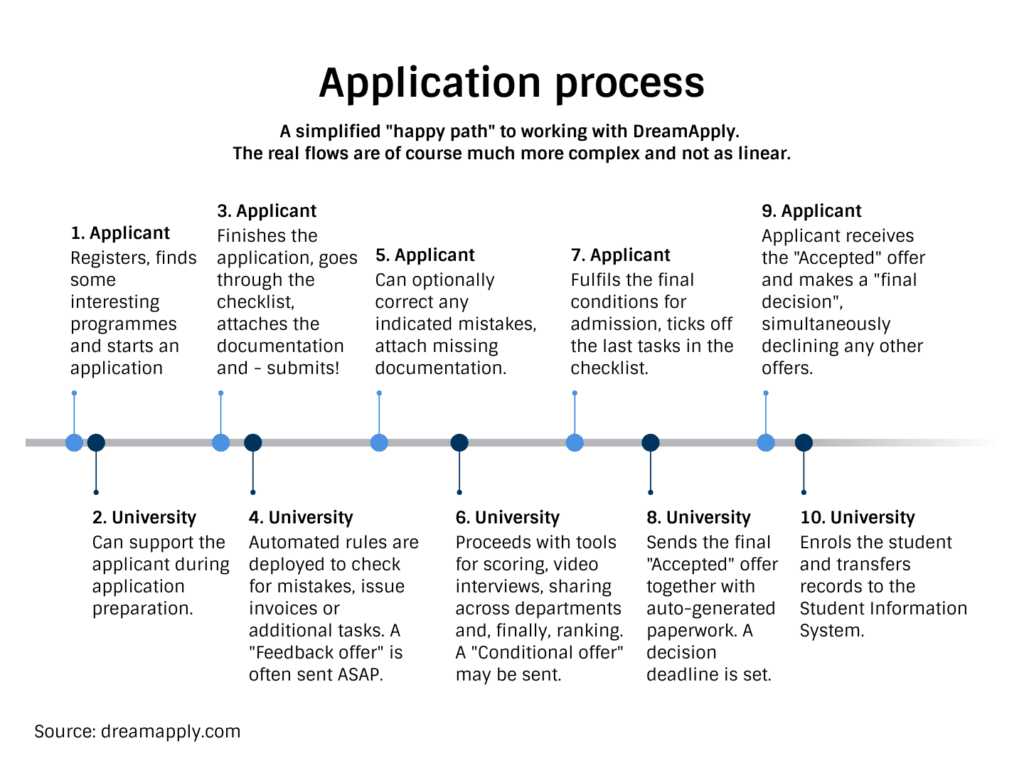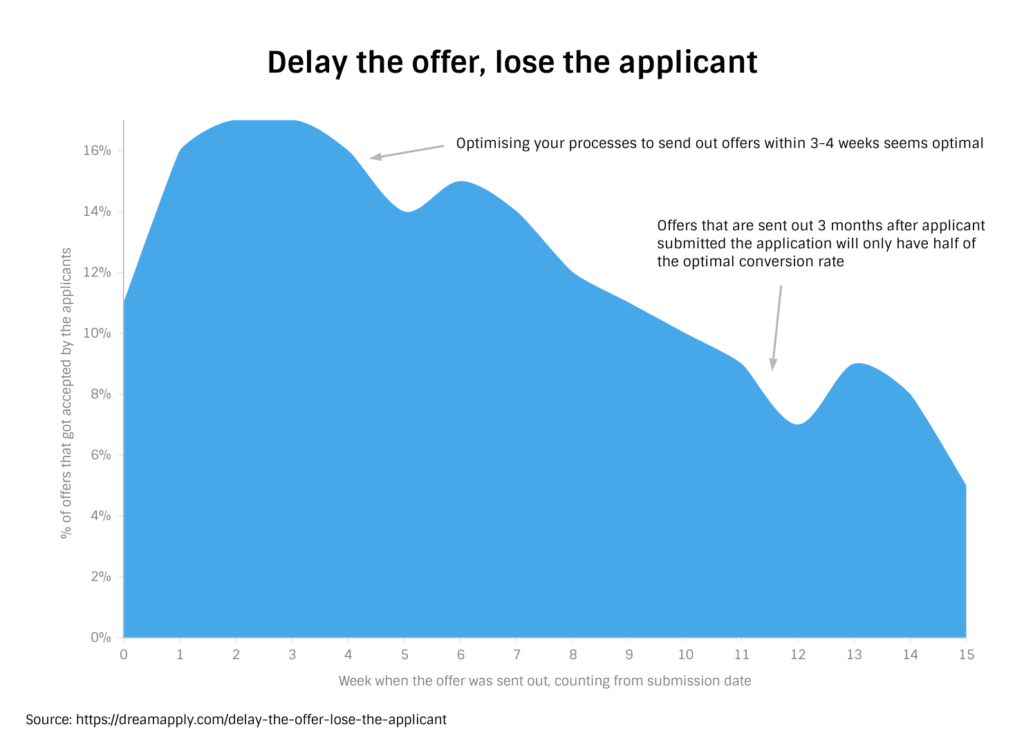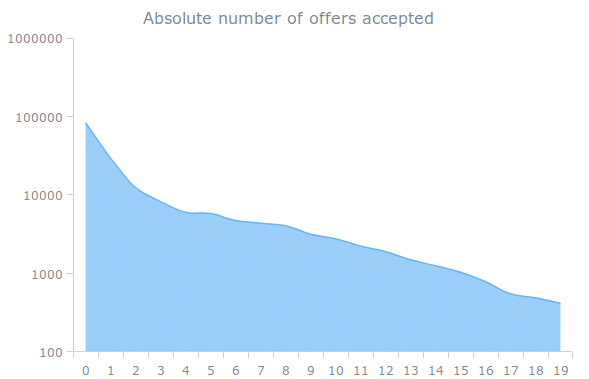This post is a follow-up to our previous article “Only 7.4% of leads become students: where did all the applicants go?” where we showed that it may take up to 10 applicants/leads in order to find a new student, with conversion losses accumulating at each step of the way.
However, we left one question unanswered. More than half of the applicants that receive their offer, are still lost.
Can you improve this by sending your offers earlier?
To find an answer, we analyzed over 175 thousand offers sent out by universities that are using the DreamApply admission system. This includes over 220 universities across a wide number of countries, receiving international students from practically every country in the world.
A short answer for the impatient:
When you are able to send your applicant a positive offer within 3 weeks, you will have a 2x better conversion rate, when compared to managing it in ~3 months.
But first, a little background
In order to better understand the numbers, lets first see how the admission process usually works for DreamApply users.

The infographic above shows a very simplified admission process for a hypothetical DreamApply user.
While each DreamApply university can build their own distinctive process flow (using any combination of our tools, checklists, statuses, invoice payments, the rules engine and so on), there are always three key steps:
- Applicant submits the application
- A “positive” offer is sent from the university
- Applicant makes the final decision, accepting the offer and confirming their study place
In the above example process, “Conditionally accepted” would be an example of what we can consider a “positive” offer. While DreamApply users can label it differently, it is clearly the point at which applicants can start feeling good about themselves and mostly technicalities lay ahead for them
Note that we had to exclude some DreamApply installations from this analysis due to their process being too complex, multi-stage or using hard-defined dates for different stages of sending out their offers. For example, if all applicants are set to receive their Accepted/Rejected offer on May 15, it becomes impossible to draw the sort of conclusions we are trying to reach. Also some installations did not contribute very much data, due to not enforcing the final applicant decision step.
What did we find?
In this analysis, we measured the time it takes from submitting the application to receiving a “positive offer” (see above). For example, some of our users are able to send out an offer in days, others may take longer to process. Then we looked at offers sent out on every week and determined how many of them were successful.

Let’s explore this data together.
On the horizontal scale there are week numbers of elapsed time from the time of submitting the application.
On the vertical scale, it shows the percentage of offers, sent on this week, that were ultimately successful (confirmed by the applicant’s “Final decision”).
For example, when we look at offers that were sent 1 week after submit, we can see that around 16% of them were successful – applicants confirmed that they will be coming to study! This metric stays relatively stable for the first 3-4 weeks, peaking at 17%.
In what is hopefully welcome news to overworked admission departments everywhere, the data shows that there does not appear to be any reason to stress about not being able to send out your offers in 1 day. Take it easy!
3 weeks seems to be a “good enough” benchmark.
It makes sense that applicants are not that time sensitive. While some applicants may receive a competing offer before you are able to send yours, there is likely enough slop in their decision-making window that allows them to still wait for and consider your offer in time.
However, if it takes more than 3-4 weeks for you to send your offer, it seems that it becomes more and more likely that it will fall on deaf ears. Either the applicant has already accepted another offer, changed their plans or has given up. Offers that take more time to send, clearly will be less successful and the downwards trend is pretty clear.
If it regularly takes you more than a month to send an offer, there is likely a lot to be gained from optimizing your processes. At the very extreme the data shows that in the worst case – taking 3 months to send an offer – your success rate will roughly be half of what it could be.
We cannot explain why offers that are sent in less than a week fare worse than offers that took 1 week to prepare. We did not observe this in all installations. For many DreamApply users the graph is a clear downward trend from day 1 (we cannot show statistics from individual DreamApply users, of course). As such, it makes a lot of intuitive sense. But overall numbers, when aggregating over all of our users, still show this interesting artefact.
Fine-print about the data
One thing to keep in mind is that the graph above does get more and more unreliable when moving from left to right. The reason for this is simple – most universities try to send out their offers sooner, rather than later.
Therefore, there are fewer data points to be analyzed for “low performing” universities, making the tail end of the graph “jumpier” and indicating that the conclusions to be drawn from this section may no longer be reliable. Consequently, we are unable to determine how many you would lose by sending your offers on week 16 vs week 15, but clearly this becomes less and less interesting as well.
Below is a graph detailing the number of offers that we had to analyze for each week.

Note that the vertical scale of the graph is logarithmic and each gradation on the Y axis represents an order of magnitude drop. For week 0 (meaning less than 1 week response time) we had close to 100 thousand offers to analyze. 2 weeks later, that number drops to around 12 thousand offers, highlighting the success of our users in being able to send out the majority of their offers without much delay. The number of offers that took 15 weeks or more to send out dips below a thousand, marking a point from where no further conclusions can be drawn.
Careful readers may also wonder why the success percentages are so small, never going above 17%, while we stated in the beginning that around half of applicants are lost at this stage. Clearly, if the success rate never goes above 17%, we would be losing 83% (100-17) even at the best of times. The secret we are missing here is – priorities! In DreamApply each applicant can specify any number of choices on a single application (limited by the university) and typically they receive offers for several of them. Confirming one offer automatically means declining the remaining. This is why individual offers have an artificially lower success rate than applicants when taken whole.
About DreamApply
Founded in 2011 in Estonia, DreamApply is an innovation-driven EdTech organization improving access to education around the globe. DreamApply’s application management software helps more than 300 educational institutions across 40 countries improve admissions, marketing, scholarship management and other internal processes.
DreamApply’s easy-to-use and customizable software increases student enrollment by 30% and reduces application processing time by 40%. With features designed with and for educational institutions, and integrations with commonly used systems, DreamApply empowers teams to get more done with less effort.
Continue exploring by requesting your free, personalized demo.
Subscribe and be the first to receive new case studies, podcast episodes, blog articles and other EdTech resources.

